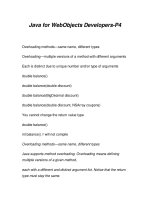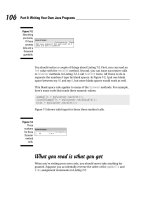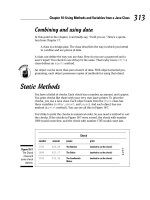Java for WebObjects Developers-P2
Bạn đang xem bản rút gọn của tài liệu. Xem và tải ngay bản đầy đủ của tài liệu tại đây (73.77 KB, 40 trang )
Java for WebObjects Developers-P2
You can nest code to avoid creating variables
Often, you need to create an object merely for the purpose of giving it
to another object. You don’t
need your own reference variable in the meantime. Java syntax
allows you to nest the code for
creating an object within the list of arguments you are sending to
another object’s method. Create it,
pass it, and forget about it—all in one statement.
In a similar spirit, you often need to send a message to get an object
then immediately send a
message to that object to get what you’re really after. For example,
assume you need the name
of the customer that owns the shopping cart. You could create a
temporary variable to hold the
intermediate object:
Customer customer = cart.shopper();
String name = customer.lastName();
But in this case, you are interested in the name, not the customer.
Java syntax allows you to connect
multiple messages into a single expression where each subsequent
message is sent to the return
value of the previous:
String name = cart.shopper().lastName();
To generalize, wherever you need to supply an object reference, you
can supply any expression that
returns an object reference.
Java for WebObjects Developers • Chapter 2 23
Character strings are objects
Character strings are instances of the class String
String name = shopper.lastName();
You can use literal strings
String banner = "All widgets on sale";
shopper.setFirstName("John");
You can concatenate strings with the “+” operator
String fullName = "John " + "Doe";
Customer s = cart.shopper();
fullName = s.firstName() + " " + s.lastName();
Strings are immutable—once created, you cannot change their value
Character strings are objects
Java represents character strings as objects. They are instances of
the class named String. Strings
are simple values and are used to represent basic object attributes.
Because they are so common,
convenient handling of strings is built into the Java language itself.
You can use a literal string value in quotes as an alternative to
constructing a string object literally.
Notice that the following two lines are equivalent:
message = "hello";
message = new String("hello");
You can combine strings—concatenate them—using the plus
operator. This creates a new string
instance that combines the values of operands. The String class
provides additional methods for
manipulating strings—consult the Java documentation to learn more
about them.
Strings are immutable: once they are created, you cannot change
their value. If you wish to modify a
string without creating a separate result string, you can use the
StringBuffer class.
The fact that many objects represent attributes as strings reveals
something fundamental about
objects: objects are typically composed of other objects. A customer
is an object. A customer has a
name—a string—which is itself another object.
24 Chapter 2 • Java for WebObjects Developers
All objects have string representations
All objects have a string representation
String debugString = shopper.toString();
Concatenation automatically obtains the string representation
String debugString = "Customer = " + shopper;
You can print strings to your application’s standard output
System.out.println(debugString);
System.out.println(shopper);
System.out.println("Customer is: " + shopper);
System.out.println("Last name = " +
shopper.lastName());
All objects have string representations
Regardless of its class, any object can generate a string
representation of itself. This is useful for
debugging and for displaying a value in a user interface such as a
Web page. Every object in Java
responds to the message toString().
You can print a string to the standard output unit of your application
using the println()
message. Consider the following code:
System.out.println("hello");
This statement is saying, “send the println() message to the out object
which is available as
a public attribute of the System object.” What happens when you
pass an argument that is not a
string? Consider the following:
System.out.println(shoppingCart);
The println() method automatically accesses the string representation
of the shopping cart
object by sending it the toString() message. The object generates a
string suitable for printing.
This also takes place when you use the plus operator to concatenate
strings.
message = "Customer = " + customer;
The customer object is not a String object but the statement
automatically obtains a string
representation by sending toString() to the customer, equivalent to:
message = "Customer = " + customer.toString();
Java for WebObjects Developers • Chapter 2 25
Java provides non-object primitive data types
Java is a hybrid language—some data are not objects
For efficiency, Java provides primitive data types
Many object attributes use primitive types
Many method arguments and return values use primitive types
Manipulate primitive types with built-in operators, not methods
Don’t create using new—the variable and the value are the same
Java provides non-object primitive data types
Java is a hybrid language—not everything in Java is an object. For
efficiency and convenience, Java
provides primitive types for simple things like numbers, characters,
and boolean values.
Even when working with objects, you will need to handle primitive
types. They are used to represent
many object attributes—the number of items in a shopping cart, for
example. They are also used for
many method arguments and return values.
Primitive types are much like basic data types in traditional non-
object-oriented languages. You
handle primitive types differently than objects in two fundamental
ways:
• Manipulate primitive types with operators not methods.
• Don’t instantiate primitive types—there is no difference between a
value and a reference to the
value, they are the same.
26 Chapter 2 • Java for WebObjects Developers
Useful subset of primitive data types
Type Contains Examples
byte 8-bit signed value Any arbitrary bit pattern
char 16-bit unicode character 'a','0', \u00F1
int 32-bit signed integer 10, -5
double 64-bit IEEE floating point 10.5, -5.2
boolean 1-bit true or false value true, false
Useful subset of primitive data types
Java defines several primitive types. Here is a useful subset: byte,
char, int, double, and
boolean.
char represents 16-bit Unicode characters, not the traditional 8-bit
ASCII characters used in
languages like C and C++.
int is always 32 bits regardless of the underlying hardware platform.
This fixes a number of
portability issues inherent in C and C++ due to different word sizes on
different machines.
Additional types not shown above offer different possibilities for
number values: short, long and
float. They differ in size and magnitude, and reflect the C and C++
origins of Java.
Java does not provide any unsigned types.
boolean values use 1 bit and have only two possible values—true
and false. These are Java
keywords. Unlike C and C++, Java does not allow numbers or
references to be used directly as
boolean values. For example, 0 is always the number 0, not the
boolean value false.
The table above shows that literal values are allowed for all primitive
types. Wherever you need to
supply a primitive type, you can supply a variable, a literal, or an
expression that results in a primitive
type value.
Java for WebObjects Developers • Chapter 2 27
Useful arithmetic operators for primitive types
Arithmetic operators
+ addition
– subtraction
* multiplication
/ division
% remainder
Arithmetic operators produce a numerical result
Use ( ) for grouping and precedence
Useful arithmetic operators for primitive types
When working with primitive number types, you use operators not
messages. Java provides the
standard arithmetic operators: +, -, *, /, and %. Java provides several
additional operators not
shown above such as ++ for increment or += for a combination of
addition and assignment. Java
also provides bitwise operators.
Arithmetic operators expect primitive number operands and produce
primitive number results—
likewise for any arithmetic expression of arbitrary complexity. Do not
confuse primitive number
values with either boolean or object values. There is one exception:
the + operator is also valid for
concatenating string objects. The result of concatenation is a string
object. This is the only case in
Java where an operator is overloaded to support object rather than
primitive types. This is built into
the language. Java does not support operator overloading for custom
classes.
You can use parentheses for grouping and readability. Because of
the precedence rules in Java,
you many need to use parentheses to enforce the meaning of an
expression when the default
precedence produces unexpected results.
28 Chapter 2 • Java for WebObjects Developers
Useful boolean operators for primitive types
Relational operators Logical operators
== equal to && AND
!= not equal to || OR
> greater than ! NOT
>= greater than or equal to
< less than
<= less than or equal to
Relational and logical operators produce a boolean result
Use ( ) for grouping and precedence
Useful boolean operators for primitive types
You can perform a variety of boolean tests using the relational
operators: ==, !=, >, <, >=, and <=.
The relational operators are valid only for primitive types with the
exception of == and != which
you can also use for comparing object references (more on this
later—see “You can perform basic
object tests”). The result of an expression using relational operators is
a boolean value—true or
false.
You can join multiple boolean expressions using the logical
operators: &&, ||, and !. The logical
operators work only with boolean operands. The result of any
boolean expression is a boolean type
value.
Java for WebObjects Developers • Chapter 2 29
Code examples using primitive types
Variable definitions
int count;
double price = 10.75, discount = 0.15;
double total = price * count * (1 - discount);
boolean orderConfirmed = false;
Statements
count = count + 1;
orderConfirmed = true;
total = cart.total() * (1 - discount);
shopper.setCreditLimit(500.00);
shopper.setCreditLimit(500.00 * 0.75);
shopper.setCreditLimit(cart.total());
Code examples using primitive types
You can define variables of primitive types including an initial value.
The initial value can be the
result of an expression using literals, other primitive variables, and
even messages to objects that
return primitive values. You can define multiple variables of the same
type in one statement. Use
the comma to separate the names. If you attempt to use a variable
that has not been initialized or
assigned, the Java compiler will generate an error.
Java’s syntax permits great flexibility in building expressions using a
mixture of literals, variables,
messages to objects, and nested expressions. The key is to make
sure the resulting type of each
component in the expression matches the overall type, in this case, a
primitive non-object type.
30 Chapter 2 • Java for WebObjects Developers
You can make decisions for conditional logic
Simple conditional statement with if and a boolean expression
if (orderConfirmed)
cart.checkOut();
Either-or logic using else
if (cart.getItemCount() >= 10)
discount = 0.25;
else
discount = 0.10;
Complex boolean expression
if (cart.getItemCount() > 0 && !orderConfirmed)
askForConfirmation = true;
You can make decisions for conditional logic
Boolean expressions enable you to make decisions. Often, your code
is conditional—you only want
to execute it under certain circumstances. For example: if the
customer is ready, then send the
shopping cart through check out.
Java provides the if and if-else statements for these occasions. if
uses a parenthesized
boolean expression to determine whether or not the subsequent code
should be executed. If the
expression is true, the code is executed. If false, it is not. The else
keyword is optional and
provides the alternative choice. If the expression is true do one thing,
else, do the other.
The simplicity of the if-else statement is deceptive. Its flexibility
permits multi-way decisions of
arbitrary complexity:
if (subtotal > 1000)
discount = 0.20;
else if (subtotal > 500)
discount = 0.10;
else
discount = 0;
Java also provides the switch statement and a conditional operator
for making decisions. These
are not shown here.
Java for WebObjects Developers • Chapter 2 31









